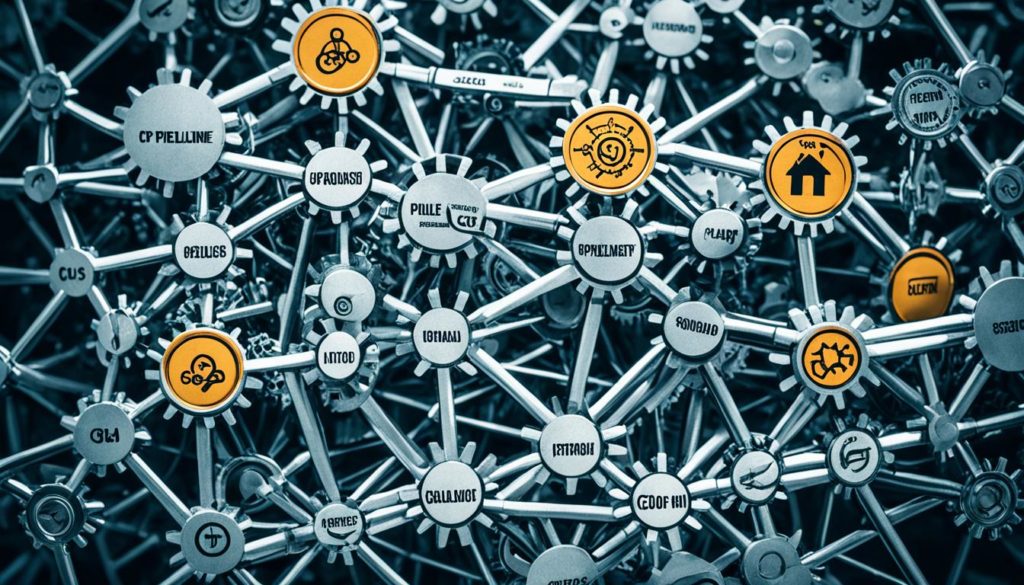
Did you know companies with automated builds move faster? Automated builds quicken development and help find problems early. This improves work when many developers are involved. It introduces numerous benefits to the practice of Continuous Delivery best practices.
In today’s tech world, organizations increasingly embrace Continuous Delivery (CD). CD focuses on DevOps best practices and updates software in cycles. It breaks down old barriers, letting products reach users quickly for valuable feedback.”
CD thrives on continuous enhancement, informed by data and flexible processes. It merges customer feedback with improved workflows. This approach leads to efficient and effective delivery to the market. Let’s see how using these strategies brings success.
Key Takeaways
- Automated builds speed up development and identify problems early.
- Tools like Jenkins and Bamboo make automation easier in development.
- Version control is key for better collaboration and safety.
- Deploying automation tools minimizes errors and makes releases faster.
- Feedback loops and reviews encourage ongoing improvement.
Understanding Continuous Delivery best practices and applying them can change your development for the better. Quick delivery and improved software quality become possible. Explore these tips and insights for success!
Understanding Continuous Delivery and Its Importance
Today, continuous delivery (CD) changes how we deploy software. It’s all about fast and reliable updates through an automated process. This approach is a key part of software development best practices.
What is Continuous Delivery?
Continuous delivery makes sure code changes get ready automatically for being released. Using a CD pipeline, developers add and test code bit by bit. This leads to quicker and safer software updates. Such a process lowers the chance of making mistakes and gets better software out faster.
The Role of DevOps in CD
DevOps is crucial in the continuous delivery setup. It builds a team spirit between developers and operations staff. With this teamwork, we can better automate things, handle continuous integration, and keep improving. This makes delivering software faster and more flexible.
Benefits of Continuous Delivery
Continuous delivery brings many important gains. Here are a few:
- More frequent updates
- Lowered costs of deployment
- Less time to reach customers
- Better quality software
- More satisfied customers
Mixing CD with new ways of working means we can release software quickly and well. This makes continuous delivery essential in modern software development.
Building a Solid Continuous Delivery Pipeline
Building a good Continuous Delivery pipeline starts with basic steps. We need to commit code often and combine changes early to avoid problems. Adding automated builds and tests helps catch mistakes early and keeps quality high. Using version control, like Git, lets developers work together and keep track of all changes.
Commit Early, Commit Often
Committing code early and often is key to a great Continuous Delivery pipeline. Doing this catches issues early, makes combining changes easier, and boosts team productivity. By updating the repository frequently, we keep everyone on the same page. Tools like GitLab CI/CD make this automation possible, encouraging continuous improvements.
Automated Builds and Tests
Automated builds and tests are vital. With tools like Jenkins, Travis CI, and CircleCI, we can easily manage the build process. These tools help do different tests and check that changes meet quality standards.
Version Control Systems
Version control is crucial for a strong Continuous Delivery pipeline. Git is popular because it’s flexible and great for teamwork. It helps with collaboration, reviewing code, and keeping a history of changes. While SVN is also useful, Git is more widely adopted. To learn about version control and CI/CD tools, read this informative article.
To make our pipeline more efficient, we use solid version control, do regular builds, and commit code often. This builds a culture of continuous feedback and improvement. For more CI/CD practices and strategies, check out this resource.
Continuous Delivery Best Practices
It’s crucial to follow top-notch practices in Continuous Delivery to keep our work smooth and consistent. Let’s check out some key actions that can make our CI/CD processes way better.
Maintain Green Builds
Keeping our builds green by quickly fixing any failures is key. This stops small problems from getting bigger. CI pipelines that run in under 10 minutes give quick feedback to developers. Using container images in different environments also helps, as Google Kubernetes Engine suggests.
Streamline Tests
It’s important to focus on quick, high-impact tests instead of trying to test everything. This keeps the team moving fast and gives devs timely feedback. Using caches for dependencies and a smart test plan cuts down on time. We also need Unit, Integration, and Functional tests for high software quality.
Deployment Automation
Automating our deployments makes releases smooth and mistake-free. Codefresh advises not to rebuild container images in different CI/CD stages. This avoids problems. By promoting images through environments and using GitOps, we get reliability and easy rollback options.
Blue-Green Deployments and Feature Toggles
Blue-green deployments help us update without downtime by switching between two running versions. Feature toggles give us precise control over new features, reducing risks. According to XenonStack, using on-demand environments and automating QA ensures our software is released in top condition.
By focusing on staying green, smart testing, deployment automation, and using blue-green deployments and feature toggles, we boost our CI/CD game. These steps not only lower bugs but also make developers more productive and customers happier.
Leveraging CI/CD Tools for Deployment Automation
Deployment automation gets a big boost from tools like Jenkins and Bamboo. They make automated builds easy and help streamline the whole process of getting software out there.
For example, using Jenkins helps integrate changes in code continuously. This reduces errors made by people and keeps the development consistent. Jenkins is famous for having a lot of plugins, making the CI/CD pipeline strong and able to grow.
Bamboo is another great tool, especially with its built-in deployment projects and connection with Atlassian’s tools. The detailed logs from builds and strong diagnostics help in fixing bugs faster. This improves the quality of the software.
By using these tools, we make our deployment cycles fast and reliable. Getting feedback quickly helps keep software quality high. It also lets us deliver our products to the market on time.
| Tool | Main Features |
|---|---|
| Jenkins | Extensive plugin support, automated builds, scalable pipelines |
| Bamboo | Integrated with Atlassian suite, detailed build logs, robust diagnostics |
With powerful CI/CD tools, automating builds and deployment becomes easier. This leads to fast updates and continuous improvement. Adding Jenkins and Bamboo to our approach makes our software delivery quick, efficient, and steady.
Fostering a Culture of Collaboration and Continuous Improvement
In the Continuous Delivery (CD) world, promoting a culture of teamwork and ongoing betterment is key. We leverage the strengths of teams with varied expertise, integrate continuous feedback, and commit to never-ending learning. This strategy boosts synergy and constant growth.
Cross-Functional Teams
Teams with mixed skills are crucial in our CD efforts. They lead to quicker decisions and better products. By having developers, testers, and operations staff collaborate, we eliminate barriers. This approach makes our product development agile and successful.
Regular Feedback Loops
Feedback loops are vital for our improvement. They help us quickly find and solve issues. This approach drives innovation and ensures our software meets user needs. It also creates a proactive culture of solving problems and being accountable.
Continuous Learning and Improvement
We’re committed to continuous learning and enhancement in our CD culture. By reviewing our processes often, we find and act on opportunities to get better. This boosts everyone’s skills and the team’s overall strength. Emphasizing continuous learning encourages growth and collective achievement.
- Continuous improvement through retrospectives.
- Collaborative problem-solving.
- Skill enhancement via continuous learning.
| Aspect | Benefit |
|---|---|
| Cross-Functional Teams | Enhanced decision-making and product quality |
| Regular Feedback Loops | Immediate issue rectification and innovation |
| Continuous Learning and Improvement | Consistent enhancement of skills and practices |
Conclusion
Embracing continuous delivery best practices is key for a successful, advanced software development process. These practices allow us to meet the demand for speed and quality. This ensures our success and a competitive advantage in the market.
We refine our methods and work together to keep our CD pipeline strong. Release and deployment automation are very important. They let teams give great value to customers. This matches the DevOps movement’s goals of agility, automation, and getting better all the time.
Adopting continuous delivery best practices is a journey, not just a goal. As we improve, using these practices helps us stay innovative. We can deliver software products that not only meet but exceed customer expectations.
FAQ
What is Continuous Delivery?
Continuous Delivery (CD) means auto-prepping code changes for production release. It makes software releases faster and more reliable by automating many steps.
How does DevOps support Continuous Delivery?
DevOps brings together development and operations teams to automate processes. This helps make builds and deployments quick and reliable. It also creates a culture of continuous improvement.
What are the benefits of Continuous Delivery?
Continuous Delivery lets us release updates more often and at lower costs. It reduces the time to market and improves quality. This leads to happier customers and a competitive advantage.
Why is it important to commit code early and often?
Early and regular commits reduce merge conflicts and identify issues quickly. They make the Continuous Delivery pipeline smoother and more efficient.
What role do automated builds and tests play in CD?
Automated builds and tests quickly check and validate code changes. They keep quality high, catch errors early, and cut down on manual testing.
How does version control contribute to a solid CD pipeline?
Version control lets developers work together effectively and track changes. Along with frequent commits and builds, it supports a robust Continuous Delivery system.
What are green builds, and why should they be maintained?
Green builds are successful tests that show software is ready to deploy. Keeping builds green ensures any problems are fixed fast, keeping the software deployable at all times.
How can deployment automation improve the release process?
Deployment automation means fewer manual mistakes, faster releases, and consistent delivery. Tools like Jenkins and Bamboo make deployments easier, letting teams focus on new features.
What are blue-green deployments and feature toggles?
Blue-green deployments use two identical environments to cut downtime. Feature toggles can turn new features on or off without new code. This approach allows for quicker adjustments and feedback.
Why are cross-functional teams important in CD?
Cross-functional teams mix different skills, improving decision-making and product quality. They help speed up development, solve problems faster, and make delivery more unified and efficient.
How do regular feedback loops enhance Continuous Delivery?
Regular feedback loops help quickly find and fix software issues. They also ensure the software meets user needs by incorporating their feedback, keeping quality high.
What is the significance of continuous learning and improvement in CD?
Continuous learning and improvement keep CD practices effective. Teams regularly review and improve their work, driving better product and process advancements.
Future App Studios is an award-winning software development & outsourcing company. Our team of experts is ready to craft the solution your company needs.










